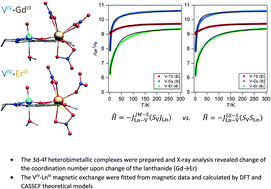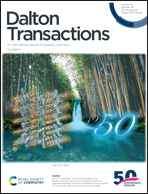3d–4f magnetic exchange interactions and anisotropy in a series of heterobimetallic vanadium(iv)–lanthanide(iii) Schiff base complexes†
Abstract
A series of heterobimetallic LnIII–VIV compounds [Ln(VO)L(NO3)3(H2O)] (Ln = Gd(1), Tb(2), Dy(3), and Er(4)) assembled by a Schiff base ligand (H2L = N,N′-bis(1-hydroxy-2-benzylidene-6-methoxy)-1,7-diamino-4-azaheptane) were prepared and studied with experimental and theoretical methods. The single-crystal X-ray analysis revealed the change of the coordination number from 10 found in 1–3 to 9 confirmed in 4. The DC magnetic data were fit with several Hamiltonians to extract the exchange and anisotropy parameters of complexes 1–4. This investigation of magnetic properties was carried out using both DFT and CASSCF theoretical calculations. It was found out that exchange interactions in 1, 3 and 4 are antiferromagnetic, while 2 has ferromagnetic exchange interactions. Moreover, the AC susceptibility measurements revealed the field-induced slow relaxation of magnetization in complexes 2 and 3 which is complicated by the presence of three relaxation channels. Nevertheless, these compounds belong to the first TbIII–VIV and DyIII–VIV single-molecule magnets in this class of compounds.

- This article is part of the themed collection: Spotlight Collection: Lanthanide and transition metal complexes as molecular magnets


 Please wait while we load your content...
Please wait while we load your content...